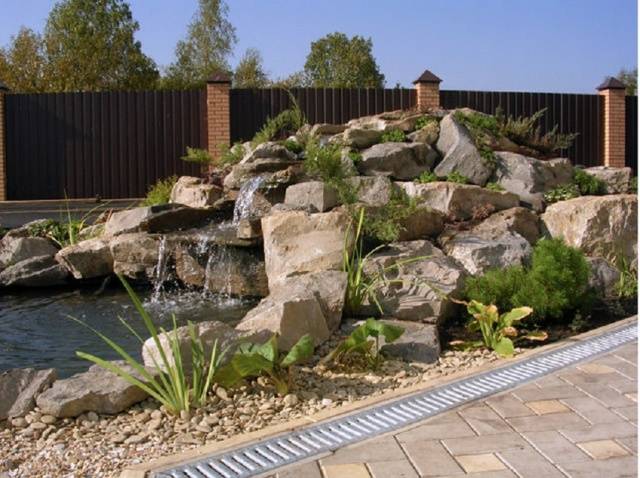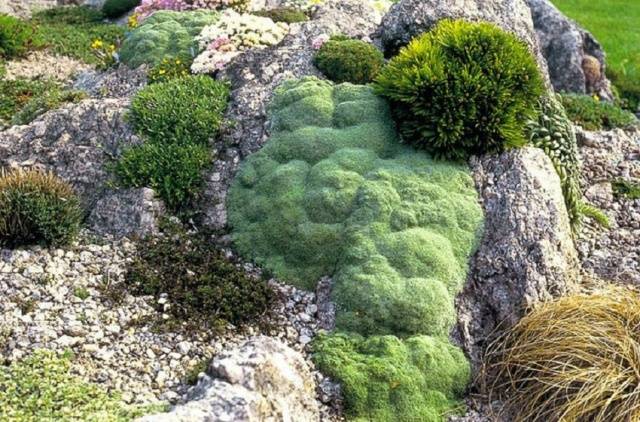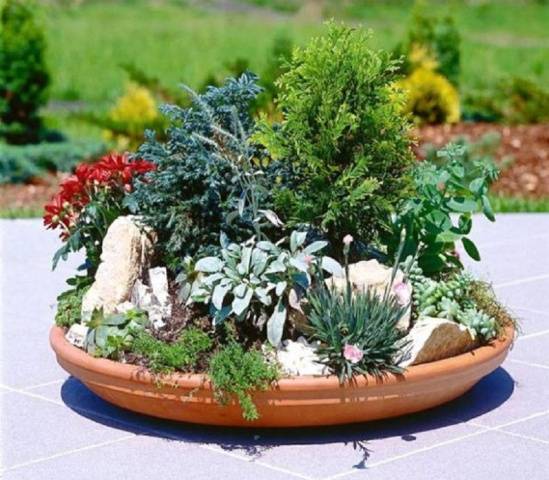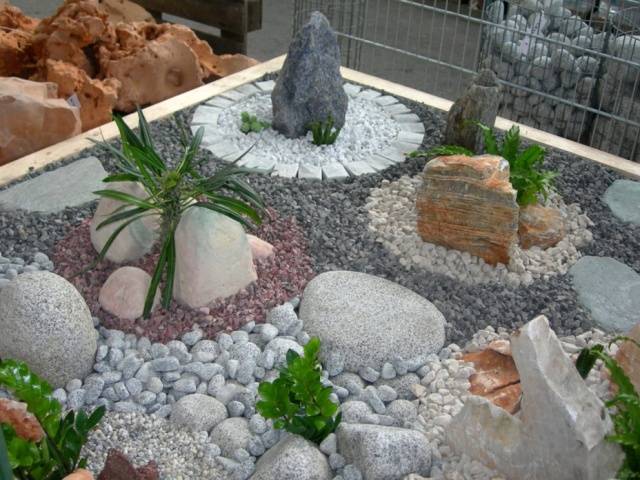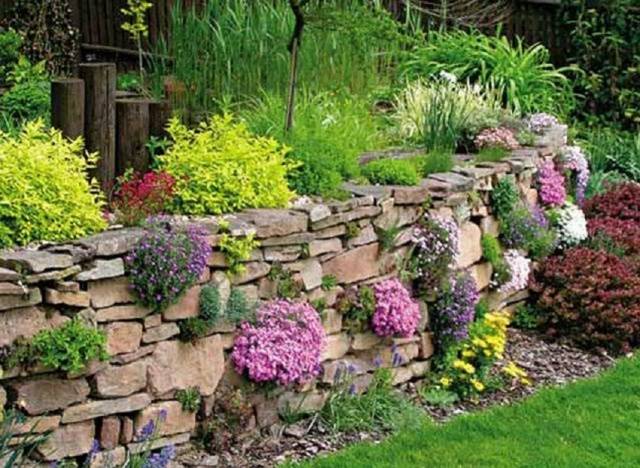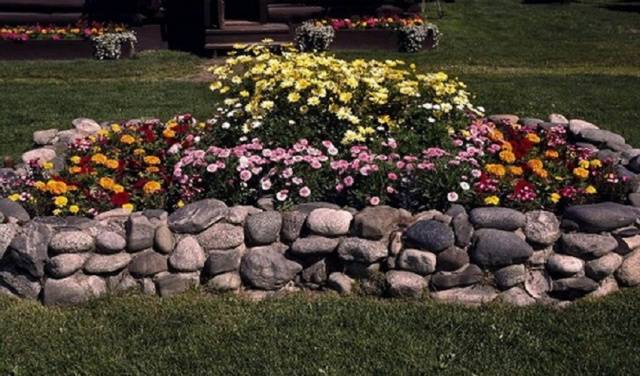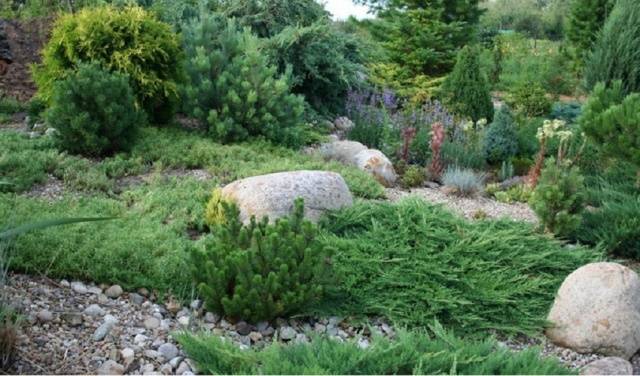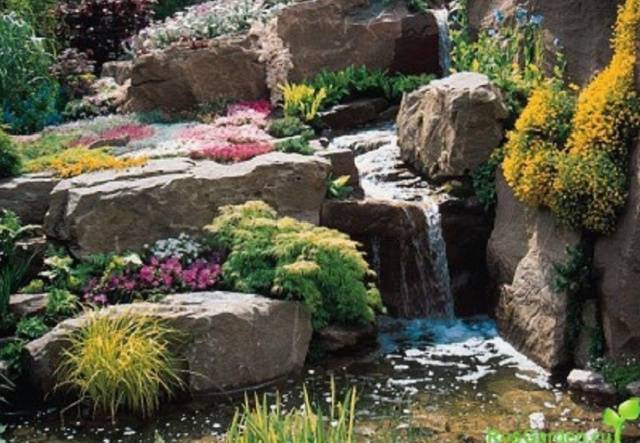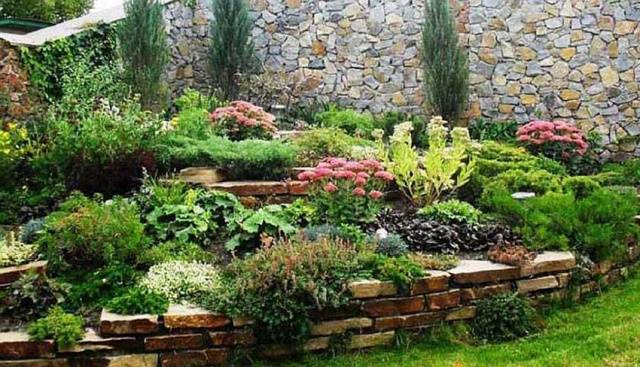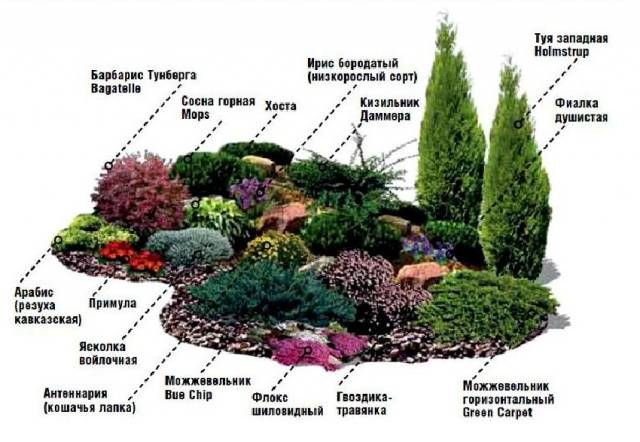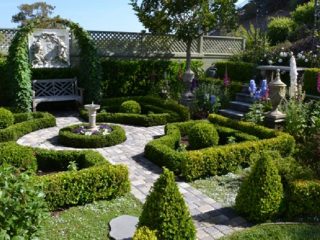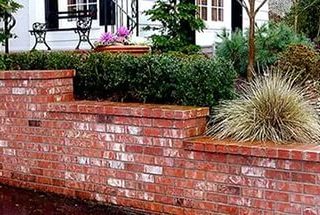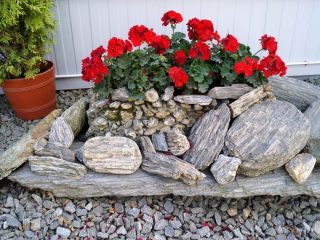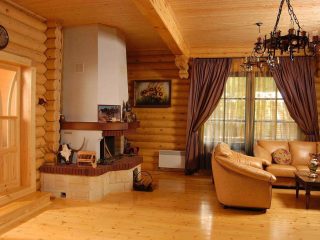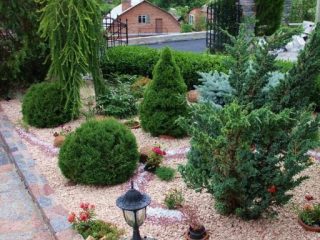Content
Some summer residents entrust the design of their plot to professionals, while others try to implement creative ideas on their own. In any case, landscape design is not complete without creating picturesque areas, original combinations and unexpected solutions. The highlight of many projects is an alpine slide or rock garden.
Originally from the Mediterranean, combining all the features of wild nature, such an exotic guest instantly transforms the entire appearance of the site. It creates a real feeling of the presence of a piece of the Alpine mountains with rock formations and lush vegetation among the compositions familiar to our eyes.
Do-it-yourself landscape design is extremely exciting, beautiful and extraordinary. After all, even the author will not be able to repeat exactly the same solution. A correctly selected combination of plants and shrubs, organically placed stones - this is a rock garden. But at the same time, it is very important to plan it so that it does not look like an ordinary pile of stones among the green mass, but fits harmoniously into the rest of the landscape.Like any design element, the rock garden exists in various modifications.
Schemes of rock gardens differ in the principle of selection and placement of stones. We will try to focus on the most common ones.
Which rock garden to choose
As soon as the decision is made to create a rock garden on the site, the question immediately arises: “Which is better?” The most familiar variety is considered to be the Alpine slide. Some even believe that these concepts are absolutely identical. But there are many more types of rock garden. And it is very difficult to determine which one is better. Anyone can add beauty to the site, but we’ll try to find out which one is right for you. Meet the “smallest” ideas:
Miniature or container rock garden
A very convenient look that can be placed in any part of the site. Any containers except plastic ones are suitable for its creation. Various types of troughs, a stump or log, a stone with holes, a clay vessel, even a walnut shell - everything will serve well. Home designers don’t have to limit themselves to get an original rock garden. After all, it can be placed even where there is very little free space. Beautiful design and competent selection of plants is all that is required. For such a rock garden, small stones and miniature plants are selected. Recommendations:
- It is advisable to take neat pebbles that go well with the container;
- plants – slow growing or dwarf;
- Be sure to use the laws of composition.
There is some complexity in this, but you will definitely have to adhere to the technology of the device. Otherwise, you can just get a set of stones.
Mosaic
Another type of rock garden for a small area. The costs of its creation are minimal, and the garden acquires much more charm, beauty and comfort. The main materials for decorating such a rock garden will be small stones. They can be plain or multi-colored. It all depends on the composition of stones and plants you have planned.
First, decide where the mosaic rock garden will be placed. You will need a small area where you need to dig a hole. Its shape should follow the intended pattern, and the depth should be no more than 20 cm. The walls of the recess should be reinforced with boards or asbestos cement. A layer of sand is first laid on the bottom, then crushed stone or gravel. The layers are compacted and filled with cement or other fastening material. Now you need a little skill. Pebbles moistened with water must be pressed into this layer before the mass begins to harden. After completing the design, it is rolled with a heavy object.
Mini rock gardens help save space and at the same time create original slides, waterfalls and streams in a reduced size.
A larger version of the rock garden is
Alpine rock or retaining wall
A very beautiful vertical rock garden.
Most often, this type is used in the construction of raised flower beds and terraced slopes. The manufacturing technology is identical to the construction of a retaining wall made of natural stone. At the time of masonry, cracks, niches or recesses are left in it. Unpretentious alpine plants that grow well with a minimum of soil are planted in these holes. You can take plants that amaze with their diversity, thyme, the moss family, juvenilia, and herbal carnation.If the size of the rock garden allows you to make larger niches, then the choice of options increases - creeping junipers, dwarf shrubs. This is very important because the vertical element requires “active” decoration. And this needs to be done with the help of different plants, because monotony in this case will not make the rock garden stand out from the background of the site. Advantages of this type of rock garden:
- No special plant care required. Rare fertilizing with mineral fertilizers is sufficient, and the solution is made in low concentration.
- Ability to create stone walls of different sizes. If the height does not exceed 50 cm, then a foundation of flat stone blocks is sufficient for strengthening. A higher wall will require a gravel or concrete pad. In this case, each tier is lined with nutrient soil and the next row of stones is laid on it. With this method, no concrete solution is used. Plant roots have sufficient conditions for development and help strengthen the alpine wall. To increase stability, you need to lay the stones inside the composition in a narrow part, while maintaining a slight slope towards the base of the rock garden.
Alpine retaining step
The height of such a rock garden is small, the project is made of natural stone, and looks very much like an ordinary step. The peculiarity of this species is the arrangement of plants. They are planted horizontally in a recess on the structure. The bottom must be equipped with drainage, then the soil is filled in, a stone composition is laid out and various plants are included in it.The result is a structure reminiscent of a flowerbed-step decorated with stones. It can be placed as a separate element, or it can be included in an ensemble with real steps. In this version, it will look like a continuation of the garden “stairs”.
Alpine garden
This name was used to identify a composition from a group of plants called “Alpines”. It is very similar to a small garden, in which the stones provide less emphasis than the plants. There are few of them, but they are placed so that the rock garden does not turn into an ordinary flower bed.
Such a garden looks best on a flat plane or slope. There are quite a lot of design options - from a monogarden to luxurious combinations. This alpine “flower bed-garden” takes up little space, but can perfectly highlight the style of your site.
Rock Garden
Another type of alpine garden, only made with a predominance of stones. In such a rock garden, a minimum number of plants are placed or, in general, they are dispensed with. The main condition is that plants should not distract attention, so trees and large shrubs are not used. The stones are selected according to their combination; the shape does not matter. The garden may contain large stones-boulders, small and medium-sized pebbles.
Rock garden-ravine
It will come in handy if you need to artificially lower the ground. Such a rock garden is placed in a recess, the edges of which are reinforced with buried stones. They are arranged in the form of a slide, decorated with varieties of moss, an artificial waterfall or stream.
This option looks very decorative and original. A type of ravine can be considered rock garden - gorge. It differs in that it is located between the hills.Allows you to play up the composition with light by creating walls of different heights from stones.
Alpine slide
The most famous and popular option.
However, not everyone knows that creating it requires a certain amount of space and knowledge. In a small area, the slide will create a feeling of bulkiness. In addition, it applies to multilayer and volumetric structures. Designing a rock garden in the form of a slide requires knowledge of the technology of arranging such design objects and the ability to combine types of stones and plants.
In addition to the above types, you can often see the following rock gardens on the site:
- mountain slope. The rock garden imitates a high mountain area. Large stones are at the top, small ones at the base. Plants are taken from high mountains.
- Valley. This rock garden composition is placed horizontally and includes stones of any size in a free arrangement. Plants of different types.
- Lawn. Stylish, but difficult to create composition. May be part of a valley, slope or hill. A special feature of the alpine lawn is that it is equipped exclusively with wild species of plants growing in high mountain conditions. Among them are carpet saxifrage, edelweiss, dwarf hyacinth, and creeping willow.
Let's start construction
Creating a rock garden with your own hands is an exciting and very creative activity. The basis for creating rock gardens are diagrams. They are carried out to scale, carefully planning the location of stones and planting locations.When placing a rock garden in the depths of the site, the location of the paths leading to it is simultaneously taken into account. Choose a place with good lighting and background. The surrounding trees and shrubs will serve well for it.
If there is a place on the site with natural relief, this is a very good option. It is good to place a rock garden next to a pond or a skillfully designed path.
The construction of a rock garden includes several stages. According to the drawn diagram, they mark out the rock garden on the site. The optimal width of a rock garden is no more than 100 cm. If you make it much wider, then caring for the plants in the central part will be problematic. The site is being prepared a little larger than the planned rock garden. Main stages of construction:
- Preparing the soil and drainage system of the rock garden to remove moisture. Choose a sunny day. The top layer of soil is removed and freed from weeds, roots, and debris. A layer of small fragments of brick is placed at the bottom of the excavation, then sand and finally crushed stone. Now return the purified soil, having previously mixed it with peat, lime and sand.
- Laying stones. From the total quantity, stones of the required shape and size are selected. Sandstone or limestone, dolomite, travertine, basalt, forest boulders with overgrown moss or lichen can provide an imitation of a mountain landscape. It is better not to use rounded stones or broken stones with a sharp edge. A few large stones will give more originality to the rock garden than a pile of small ones. The stones are used of the same type - this is very important! First, several stones are placed around the perimeter of the site. This will serve as protection against soil erosion.
- Decoration of the rock garden site. At this stage, a slope is created or the surface is leveled - the actions depend on the type of rock garden chosen. The stones are laid out naturally in the form of a terrace, cliff, plateau or gorge. The heaviest of them will require the efforts of several people. For large stones, you need to prepare a hole to lay it. Then add earth and crushed stone under the base and compact it thoroughly. Soil is poured into the spaces between the stones, but space is left for the planting mixture. To prepare it, take crushed stone or broken stone, turf soil, peat or high-quality humus. The ratio of parts is one to one. The needs of the plants need to be taken into account, so you may need to add sand to the mixture.
- Planting. Be sure to consider the degree of plant growth. Before planting, check the data for each plant. It is necessary to find out the requirements for watering, nutrition, lighting, and soil composition. An important aspect is the flowering time. You should not combine plants that will create decorative effect only in one period. Select plant species with different flowering periods.
Some planting tips:
- tall plants are not placed at the top of the rock garden;
- coniferous “dwarfs” are not combined into groups;
- ground cover plants are placed near stones to give them the opportunity to grow on them;
- The rock garden combines bulbous and ground cover crops well.
Before planting, water the soil well. First, plants are placed between the stones, then those designated for terraces and pockets. The remaining area is covered with small stones and watered again.
How to care
The rock garden needs not only to be decorated, but also to be properly cared for. It includes:
- Watering. Be sure to consider the moisture requirements of plants. It is best to create a watering schedule for each group of plants.
- Loosening and mulching. Carry out in areas of the rock garden free of stones.
- Cleaning and shaping. This stage becomes especially relevant in the autumn. Fallen leaves must be removed. Overgrown shrubs and trees should be trimmed and insulated if necessary. Spring activities include pest control and soil compaction. Sometimes it is necessary to wash the stones and remove the soil from them.
In order for the rock garden to please the owner for a long time, you need to carefully select the plants. Some do well in the sun on top of a hill or cliff, others like a little shade between rocks. Depending on the composition of the soil on your site, select appropriate crops.
This will help make the rock garden bright and well-groomed. The reference books indicate flowering time, plant height, and lighting requirements. This will make it possible to select species for planting on the south or north side of the rock garden.
The most important condition is don’t be afraid to experiment! Use more plants that are familiar to you, stones available near the site, read the advice of professionals and create your own unique rock garden from beautiful stones and plants.
